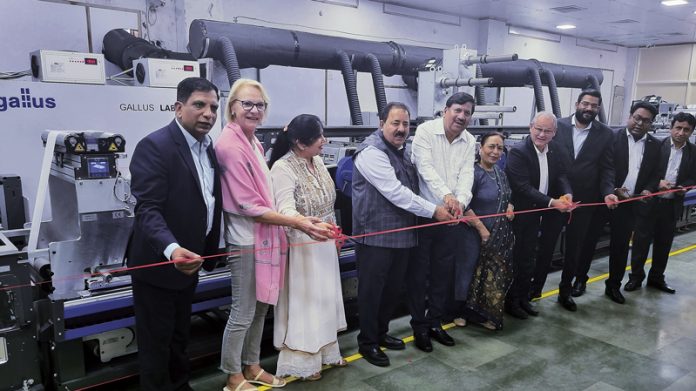
Pinnacle Traxim, based in Sonepat in the Delhi NCR, has substantially grown its label printing business since the installation of the Gallus Labelmaster 440 narrow-web flexo press in January 2022. The company says its business grew by 40% in the past year since the installation of the new machine while its overall growth trajectory from past years is at a CAGR of 15%-20%.
The company is a specialist in labels and sleeves used for containers and bottles by the FMCG, chemical, cosmetics, pharmaceutical, and alcobev markets. Lalit Kumar Gulati, managing director of Pinnacle Traxim, who co-founded the business with Surendra Kumar Juneja in 2008, says, “The Gallus Labelmaster is in our view, a first-in-class flexo press concerning quality, production capacity, and capabilities. Its operator-friendly features include dual cure drying systems, auto registration, multiple converting options like rotary screen, and other customized options as well. It maintains high quality with stable print registration at 150 meters a minute. However, the Labelmaster can print at a maximum speed of up to 200 meters a minute.”
Ferdinand Rüesch Senior, senior vice president, of Global Key Accounts of Gallus, on his recent visit to India, spoke about his visit to the Pinnacle plant. Rüesch said, “I am happy to see the enthusiasm of the press operators and their cheerfulness. It has been 11 months since Pinnacle has been operating the Labelmaster press. Congratulations to team Gallus and Heidelberg for a new family member. Gallus has put together a lot of ideas in the R&D segment of the press to make the life of the press operator easy with faster setup times and waste reduction.”
The Labelmaster 440 helps to minimize substrate waste with its short web path of 1.4 meters between print units. Gallus says the press can handle a wide choice of substrates from 15-micron mono films to 450-micron thick complex substrates such as those used for tube laminates. Optimized ink chambers on the print units ensure even ink transfer to the anilox rollers with minimal splashing and reduced foaming.
Integrated direct servo-driven printing cylinders and cooled impression cylinders for the stability of the materials in production at print speeds up to 200 meters a minute are especially important for complex laminates such as those used for lamitubes. Stable print register accuracy across all printing speeds and the flexibility of print and converting possibilities make it a versatile and productive press.
Samir Patkar, president at Heidelberg India, commented, “It’s important to scale up in the packaging industry and with the Labelmaster, Pinnacle will get the push. As the utilization of the Labelmaster press goes up with higher OEE (overall equipment efficiency), the cost of production is reduced due to the technology behind the faster setup, lower wastage, and minimal operator intervention. It was enthralling to see the work printed on the Labelmaster from 12-micron films to shrink sleeves, tube laminates, and self-adhesive labels with the finest print quality.”
Flexo printing with 250 LPI screens
Patkar added, “The team at Pinnacle is trying flexo printing with a 250-lpi screen, and I haven’t come across this in other converters in India yet, while there are a few converters who are using 175 to 200-lpi. A label converter aims for both production scale and value enhancement with embellishments as these are the recipes for success. We wish, Pinnacle Traxim a great journey ahead with the Gallus Labelmaster in fulfilling their dreams and many more Gallus presses to adorn its shopfloor.”
Sandeep Juneja, plant head at Pinnacle Traxim, said, “The Gallus Labelmaster is suitable for short and long runs, and we handle diverse clients from food to alcobev, and both labels and flexible packaging. The quality and sturdiness of the press are unmatched and while we explored other presses, the quality and productivity are exceptional with the Gallus. We had been planning to purchase the Gallus press for a long time, and it is like a dream come true now.”
The addition of the new press has given a growth boost to Pinnacle Traxim in the past year. With a consistent CAGR of 15%-20%, the company is planning to set up a second plant, perhaps north of the Delhi NCR. This development is still in the discussion stage.










